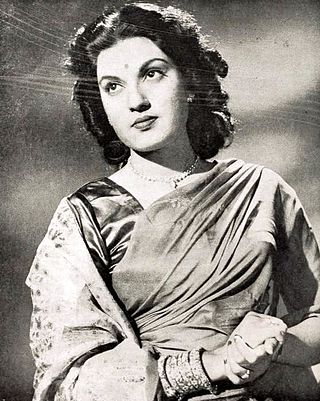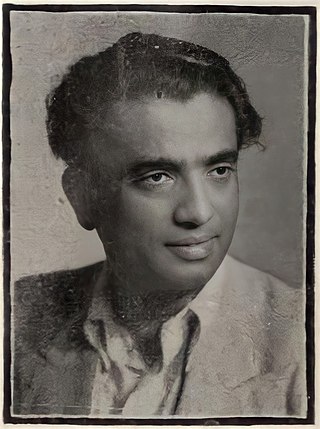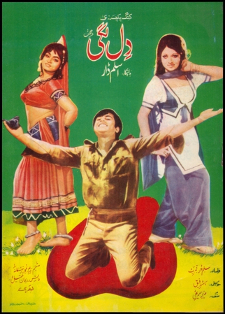
Suraiya Jamal Sheikh, mononymously known as Suraiya, was an Indian actress and playback singer who worked in Hindi films. In a career spanning from 1936 to 1964, Suraiya acted in over 70 films and sang 338 songs. Regarded among the finest and greatest actresses in the history of Indian cinema, she was known for her strong on-screen portrayals in a variety of genres. Suraiya was the most celebrated actress between the mid- to late 1940s and early 1950s and was paid more than her male counterparts.

K. Asif was an Indian film director, film producer and screenwriter who is known for his epic film, Mughal-e-Azam (1960).
Nigar Sultana was an Indian actress who worked in Hindi films. She appeared in Aag (1948), Patanga (1949), Sheesh Mahal (1950), Mirza Ghalib (1954), Yahudi (1958), Do Kaliyaan (1968) but is most notably remembered for playing the role of "Bahar begum" in the historical epic film Mughal-e-Azam (1960). She was the wife of filmmaker K. Asif.

Badnaam is a Pakistani film in Urdu language, released on 2 September 1966, adapted from Saadat Hasan Manto's short story Jhumkay ("Ear-rings") by screenwriter Riaz Shahid, and was the second film adaptation of the Manto's story after 1946 Bollywood adaptation. The film was directed and produced by Iqbal Shehzad, in his debut as a film director. Badnaam's cast included Allauddin, Nabeela, Neelo, Ejaz Durrani, Diljeet Mirza, Hameed Wain, Rangeela and Zumurrud.

Abdur Rashid Kardar was an Indian film actor, director and producer. He is credited with establishing the film industry in the Bhati Gate locality of Lahore, British India.
Dard (Pain) is a 1947 Bollywood drama film directed by Abdul Rashid Kardar. The film was produced by Kardar Productions. It was a surprise "musical hit" at the box office as it had an ordinary star cast. Suraiya played the second lead, with Munawwar Sultana as the main heroine. The film was Suraiya's first "big hit", becoming a popular singing star following the success of the film. The hero of the film was Kardar's brother Nusrat (Kardar), who shifted to Pakistan following Partition in 1947, where he acted in a few films.
Leela Mishra was an Indian actress. She worked as a character actor in over 200 Hindi films for five decades, and is best remembered for playing stock characters such as aunts. She is best known for her role of "mausi" in the blockbuster Sholay (1975), Dil Se Mile Dil (1978), Baton Baton Mein (1979), Rajesh Khanna films such as Palkon Ki Chhaon Mein, Aanchal, Mehbooba, Amar Prem and Rajshri Productions hits such as Geet Gaata Chal (1975), Nadiya Ke Paar (1982) and Abodh (1984). Her career's best performance was in Naani Maa in 1981, for which she received Best Actress award at the age of 73.

Dillagi is a 1949 Indian Bollywood film. The film was produced and directed by A. R. Kardar for his "Kardar Productions", and had music composed by Naushad. The film starred Suraiya and Shyam, alongside Chandabai, Sharda, Amar and Amir Banu. The story was a romantic tragedy and became commercially successful, being the fourth highest grossing film of the year.

Patanga is a 1949 Indian Hindi-language romantic comedy film. It was the first film produced and distributed by Varma Films; yet, it was the seventh highest grossing Indian film of 1949. The film was directed by H. S. Rawail based on a story written by his wife Anjana Rawail. Rajendra Kumar, who would become one of the leading actors in Indian cinema, worked in Patanga as an assistant to director H.S. Rawail and also had a cameo in the film. A duet sung against the backdrop of WW2, "Mere Piya Gaye Rangoon", picturised on actor Gope and lead heroine Nigar Sultana became popular. The playback singers for the song were C. Ramchandra, who also composed the music for the film, and Shamshad Begum. The cast included Nigar Sultana, Shyam, Yakub, Gope, Purnima, Shyama, Randhir and Mohana.

Kaneez is a 1949 Indian Hindi-language drama film, directed and produced by Krishan Kumar, starring Shyam, Munawar Sultana and Kuldip Kaur in lead roles.
Gope was an Indian actor of Hindi cinema. Starting his career with a small role in Insaan Ya Shaitaan (1933), directed by Moti Gidwani and produced by Eastern Arts Production, Gope went on to act in over one hundred forty films in a career spanning twenty-four years from 1933 to 1957. Several of his films were released following his death. Best known for his comedy roles, he is stated to be one of Hindi cinema's "most popular comedians". His acting in comic roles won him "critical and popular acclaim" and he soon became "the leading comedian of his time". His popularity assured him of being mentioned in the credit roll of films along with the main cast. He became famous for lip-syncing the popular number "Mere Piya Gaye Rangoon" from Patanga, playbacked by C. Ramchandra for Gope and by Shamshad Begum for Nigar Sultana.

Balam is a 1949 Hindi romantic action film directed by Homi Wadia. Credited as A Hila Wadia Production by Wadia Brothers the film starred Suraiya, Wasti, Masood, Nigar Sultana, Jayant, Gulnar and Agha. The music directors were Husnlal Bhagatram.

K. Amarnath was one of the earliest film makers of Indian Cinema. His career as a movie producer and director spanned over four decades in the film industry.

Meena Shorey was a Pakistani film actress who worked first in Indian cinema and later Pakistani cinema. She appeared in Hindi/Urdu and Punjabi films. Credited in films by her mononym, Meena, her real name was Khurshid Jehan. She started her acting career playing a character role, as Ambhi, Raja of Taxila's sister in Sohrab Modi's Sikandar (1941). Married to her fourth husband, Roop K. Shorey, by the mid-1940s, she found fame when she acted in her husband's film Ek Thi Larki (1949), opposite actor Motilal. The story was written by I. S. Johar, who also starred in the film. The "foot-tapping" music composed by Vinod became a "huge hit", with Meena becoming an "icon" for the "new liberated" young women. Meena was acclaimed as the "Lara Lappa Girl", from the song of same title in the film. She was one of the first women to be recognised in Indian cinema as a "comedienne of calibre". She was also popularly known as The Droll Queen of Partition as she worked as a comedienne [Droll] in both in India and Pakistan [countries resulting from partition].
M. Zahoor, also written as M. Zahur or Zahoor Ahmed, was an actor known for playing villains in Hindi films in India during 1930s and 40s. He was the maternal uncle of the Indian actress-singer, Suraiya, and was instrumental in her getting entry into Hindi films in Bombay. In 1941, he took her to the sets of the movie Taj Mahal, where she was spotted by the director of the film, Nanubhai Vakil, who selected her to play the role of the young Mumtaz Mahal. Zahoor also wrote the story of the film 1857 (1946), starring Suraiya and Surendra. He migrated to Pakistan along with his mother later after India's independence.
Suresh, also known as N. A. Suresh, was an Indian actor in Bollywood, who was born in Gurdaspur, Punjab, India. He acted in Hindi/Hindustani films from 1929 to 1979.

Munawar Sultana was an Indian cinema actress, who acted in Hindi films. She is cited as one of the "popular" actresses of the late 1940s to early 1950s period, along with Noor Jehan, Swarnalata and Ragini. Her specialty was playing a selfless woman, enduring the rough treatment meted by her husband and family, but who eventually "brought her erring husband back home".

Shaikh Muhammad Yusuf, known professionally as S. M. Yusuf, was a Pakistani film director and producer. He made fourteen films in British India and later after the split of India subcontinent, he worked in Pakistani cinema and made thirteen films, including a B/W film Aulad (1962) and a blockbuster film titled Saheli (1960).
Sahira Kazmi is a retired Pakistani actress, producer and director. She is best known for her role in the country's first-ever colour series Parchaiyan (1976) and for producing the cult-classic blockbuster series Dhoop Kinare (1987) and the acclaimed drama Nijaat (1993). She along with Uzma Gillani, Roohi Bano, Tahira Naqvi and Khalida Riyasat dominated the television screens of Pakistan during 1970s and 1980s.

Dillagi is a 1974 Pakistani romantic drama Urdu film directed by Aslam Dar.












